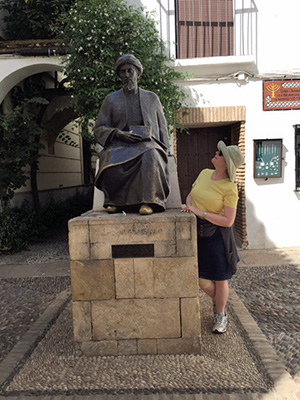
I’m not sure if the rain in Spain stays mainly on the plain, as the song goes from the musical “My Fair Lady.” Maybe that’s why I packed a raincoat, which I wore for about two minutes during a light rain shower in Barcelona. For the rest of the time on my recent trip to Spain, the weather ranged from hot to oven-like temperatures bordering on three digits, and all I wanted to do was drink cold lemon water and dash for cover into the shade. The good news is because of the high temperatures I wasn’t hungry, and there are only a few kosher options available. So, my good old American tuna packets and cheese, which I also packed, came in very handy and were put to good use.
What I do know for sure (shout-out to Oprah) is that Spain is rich in many centuries of Jewish history; breathtaking architecture, as in the Gaudi exhibits in Barcelona; and fascinating museums, as in The Prado and The Royal Palace in Madrid. In Seville, wherever you go there are several plaza and sidewalk musicians playing music of all kinds. A rousing rendition of The Beatles’ “Hey Jude” had everyone joining in. At night, it’s a magical scene against the backdrop of old cathedrals and ornate street candelabras lit up, horses and buggies clip-clopping on stone roads, people sitting in outdoor cafes chatting, eating, drinking and listening to the music.
Despite the hot temperatures, we had a memorable time railroading our way from Barcelona, Seville, Cordoba, Madrid and Toledo. In each location, we toured the Jewish Quarters and heard details of the past vibrant daily life in the communities, and ultimately the depressing and tragic series of conversions and expulsions that extended until 1492. We saw Jewish artifacts in the museums; learned more about the life of the Rambam, who was born in Cordoba; and then left Spain for Morocco and then Egypt. Our tour guide said, “Did you know that it is considered good luck to rub the shoes of Rambam’s statue? It will bring you wisdom.” In most of the synagogues, which had been mainly converted to churches, you can see remnants of the architectural and cultural influences under the Romans, Muslims and Christians. Even though there are few Jews living in these quarters presently, there are Hebrew symbols that say S’farad and pictures of menorahs molded into the roads and walls.
I was particularly impressed with our Jewish tour guides in Barcelona and Seville who are passionate about teaching and preserving the history of those communities. In Seville, Gershon led us on a highly detailed three-hour tour of the Jewish Quarter. He lives in Seville and is optimistic about the future of the community, and enjoyed describing the community Pesach seders with which he was very involved.
Dominique was our very knowledgeable guide in Barcelona. Although it also was an interesting and highly eventful tour, something unexpected happened. As the group stood in a circle listening to Dominique on a narrow path near a wall (I was closest to the wall), a bird decided to do his business on my hat. My daughter’s grossed-out expression confirmed my fears. Lesson learned. Stay away from outdoor walls. Also, you can find sympathetic people wherever you go. Thank goodness for the Purell and tissues that people in the group quickly handed me. Dominique offered the comment I’ve heard before in a similar situation. Yes, it’s happened before. “It’s mazeldich!” She barely missed a beat and continued describing Jewish life in Barcelona. But, can someone please explain what is so mazeldich about this? By the way, the hat was promptly discarded and I proceeded to get ripped off when I bought a new one later in the day. That’s what happens when you’re obviously a tourist and don’t know the language.
The final Jewish Quarter we toured was in Toledo. Again, once a thriving Jewish community, but now it has just two Jewish families. We visited the Santa Maria la Blanca Synagogue, which is the oldest synagogue in Spain, converted into a church, and now a museum. The original name was Ibn Shushan Synagogue. The tour guide showed us the area where the bima and torah used to be housed, and where the women sat. He then asked if there were any Jewish people present in the group. My daughter and I raised our hands and the tour guide (who wasn’t Jewish) asked us some further questions about Judaism. I was proud to be the Jewish representation, as if to say, you see we’re still here!
As for Shabbat, Chabad never disappoints in providing a home away from home. You meet people from all over the world, connect with those who know at least some friends and relatives and enjoy a diverse and memorable Shabbat experience. In Barcelona, the Kabbalat Shabbat davening was an interesting blend of mostly Sephardi tunes and a smattering of Ashkenazi thrown into the mix. The next day we returned and had lunch of an assortment of salads and a delicious cholent filled with chickpeas, eggs, meatballs, potatoes and exotic spices. For each meal, there was an accompanying Dvar Torah in Spanish, and the only word I recognized was “Balak.” An American from Brooklyn jumped in and delivered the Dvar Torah in English during seuda shelishit, for which I was grateful. It was an unforgettable Shabbat, also because it was the longest, ending at 10:20.
As I sat on the plane getting ready to come home, I took out my iPhone and said tefillat haderech. Just a few minutes later, the man seated next to me closed his eyes, put his hands together, and whispered a few words in prayer. Two people sitting together peacefully from different religions, praying for the same thing. A nice conclusion to a visit to Spain, wouldn’t you say?
By Esther Kook










